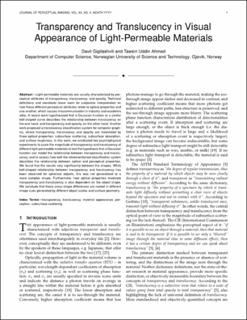| dc.contributor.author | Gigilashvili, Davit | |
| dc.contributor.author | Ahmed, Tawsin Uddin | |
| dc.date.accessioned | 2023-01-23T10:09:31Z | |
| dc.date.available | 2023-01-23T10:09:31Z | |
| dc.date.created | 2022-09-25T03:29:19Z | |
| dc.date.issued | 2022 | |
| dc.identifier.citation | Journal of Perceptual Imaging (JPI). 2022, 5 000409-1-000409-12. | en_US |
| dc.identifier.issn | 2575-8144 | |
| dc.identifier.uri | https://hdl.handle.net/11250/3045229 | |
| dc.description.abstract | Light-permeable materials are usually characterized by perceptual attributes of transparency, translucency, and opacity. Technical definitions and standards leave room for subjective interpretation on how these different perceptual attributes relate to optical properties and one another, which causes miscommunication in industry and academia alike. A recent work hypothesized that a Gaussian function or a similar bell-shaped curve describes the relationship between translucency on the one hand, and transparency and opacity, on the other hand. Another work proposed a translucency classification system for computer graphics, where transparency, translucency and opacity are modulated by three optical properties: subsurface scattering, subsurface absorption, and surface roughness. In this work, we conducted two psychophysical experiments to scale the magnitude of transparency and translucency of different light-permeable materials to test the hypothesis that a Gaussian function can model the relationship between transparency and translucency, and to assess how well the aforementioned classification system describes the relationship between optical and perceptual properties. We found that the results vary significantly between the shapes. While bell-shaped relationship between transparency and translucency has been observed for spherical objects, this was not generalized to a more complex shape. Furthermore, how optical properties modulate transparency and translucency is also dependent on the object shape. We conclude that these cross-shape differences are rooted in different image cues generated by different object scales and surface geometry. | en_US |
| dc.language.iso | eng | en_US |
| dc.publisher | Society for Imaging Science and Technology | en_US |
| dc.relation.uri | https://library.imaging.org/admin/apis/public/article_shell/uploads/article_files/IST/jpi/5/0/000409/jpi0162-s001.zip | |
| dc.title | Transparency and Translucency in Visual Appearance of Light-Permeable Materials | en_US |
| dc.title.alternative | Transparency and Translucency in Visual Appearance of Light-Permeable Materials | en_US |
| dc.type | Peer reviewed | en_US |
| dc.type | Journal article | en_US |
| dc.description.version | acceptedVersion | en_US |
| dc.source.pagenumber | 000409-1-000409-12 | en_US |
| dc.source.volume | 5 | en_US |
| dc.source.journal | Journal of Perceptual Imaging (JPI) | en_US |
| dc.identifier.doi | https://doi.org/10.2352/J.Percept.Imaging.2022.5.000409 | |
| dc.identifier.cristin | 2055090 | |
| dc.relation.project | Norges forskningsråd: 288187 | en_US |
| cristin.ispublished | true | |
| cristin.fulltext | postprint | |
| cristin.qualitycode | 1 | |
